Philippine Eagles: Critically Endangered and in Need of Protection
Philippine Eagles are critically endangered, with fewer than 400 pairs remaining. These majestic birds stand three feet tall and have a seven-foot wingspan, making them a vital part of their ecosystems.
Their survival depends on vast territories within montane and lowland rainforests, where they play a crucial role in maintaining ecological balance as apex predators. However, their habitats are being destroyed due to deforestation and illegal logging, threatening their very existence.
Hunting and environmental pollutants further jeopardize the Philippine Eagles' survival.
To combat this, conservation initiatives focus on habitat protection and community engagement, highlighting the eagles' significance in both biodiversity and cultural heritage.
Understanding the urgency of their plight is crucial, and it is essential to address habitat loss and hunting to ensure the Philippine Eagles' survival.
Overview of Philippine Eagles
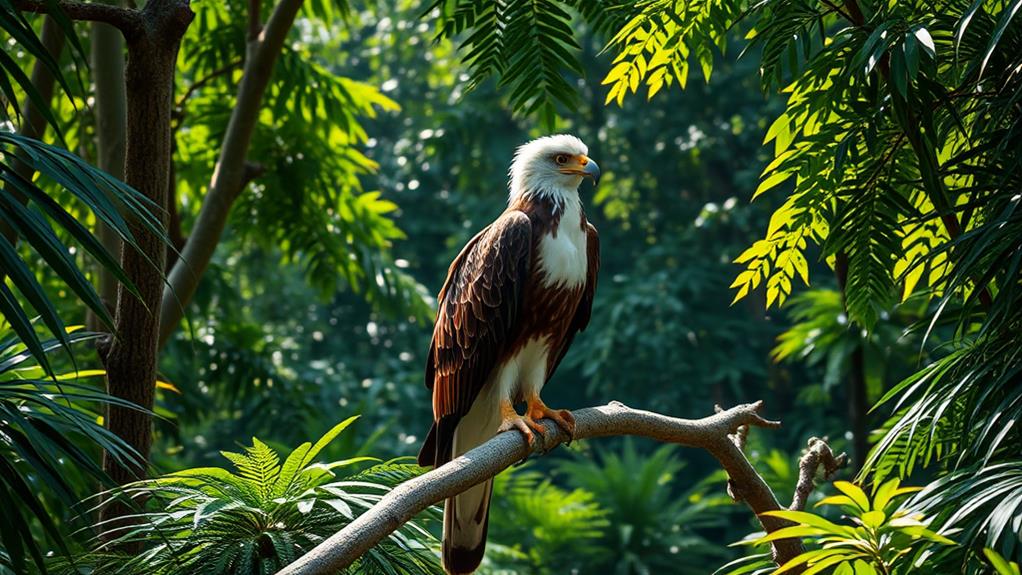
The Philippine Eagle: A Majestic yet Endangered Species
The Philippine Eagle, scientifically known as Pithecophaga jefferyi, is a remarkable raptor endemic to the Philippines. It stands about three feet tall, with a wingspan of around seven feet, and weighs up to 8 kilograms. Its distinctive feather crest adds to its regal appearance.
Habitat Loss: The Primary Threat
The Philippine Eagle is critically endangered, with fewer than 400 adult pairs remaining in the wild. Habitat loss, largely due to deforestation and human encroachment, is the primary driver of this alarming decline.
These forest raptors require vast territories, ranging from 4,000 to 11,000 hectares, to thrive. The destruction of their montane and lowland rainforest habitats severely limits their survival.
Conservation Efforts
Various initiatives are underway to protect this iconic species. These efforts aim to preserve their habitats and promote public awareness, as well as mitigate human-wildlife conflict.
Habitat and Distribution
Habitat and Distribution
The Philippine Eagle inhabits montane and lowland rainforests on four major islands: Luzon, Samar, Leyte, and Mindanao.
These birds thrive at elevations ranging from sea level to approximately 5,900 feet (1,800 meters), relying on pristine forests for nesting and hunting.
Threats to Habitat
The Philippine Eagle's distribution is increasingly restricted due to habitat loss driven by deforestation and agricultural expansion.
This has led to significant habitat fragmentation, making it challenging for young eagles to find suitable habitats and mates after fledging.
Fewer than 400 breeding pairs remain, classifying them as critically endangered.
Importance of Habitat Protection
Understanding the urgent need for habitat protection and restoration is crucial.
By preserving these rainforests, we can contribute to the survival of this iconic species.
Protecting their habitat isn't just about saving the Philippine Eagle; it's about preserving the rich biodiversity that defines the Philippines.
Threats to Survival
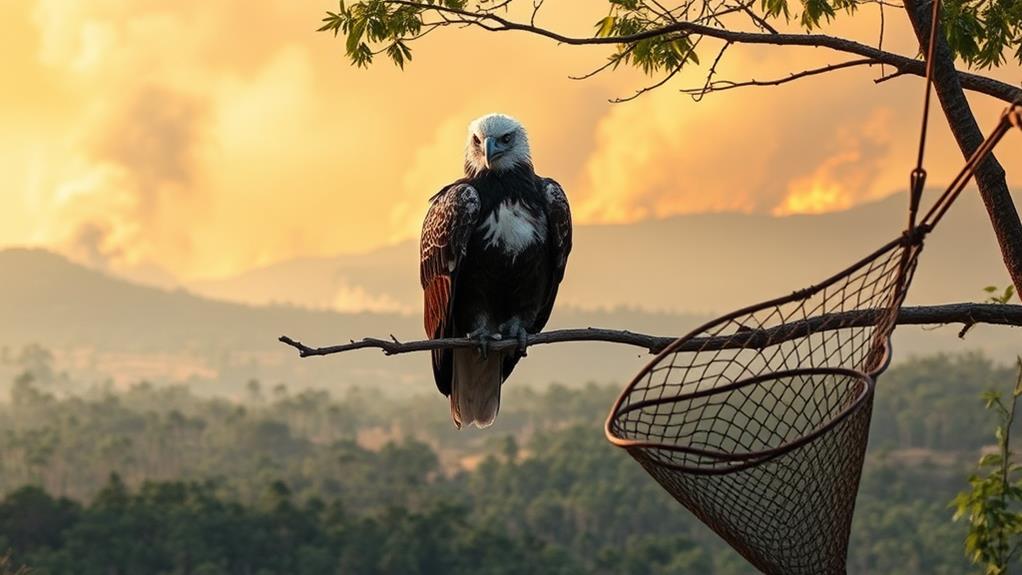
The Philippine Eagle's survival is precarious due to multiple critical threats. Habitat loss is the most pressing issue, primarily caused by deforestation in Mindanao, its primary habitat. Each year, an estimated 40,000 hectares of forest vanish, drastically reducing the eagle's living space and prey availability.
The eagle faces several threats, including:
Illegal logging fragments their habitat, making it difficult for the eagles to find food, shelter, and potential mates. For example, when forests are cut down, eagles are left with limited space to build their nests and hunt for prey.
Hunting is another significant threat, as local farmers often kill eagles to protect their livestock. Eagles are mistakenly seen as a threat to farm animals, leading to their persecution.
Environmental pollutants from agricultural practices harm the eagles' health. Pesticides and other chemicals used in farming contaminate the eagles' food sources, affecting their reproductive health and overall well-being.
With fewer than 400 nesting pairs left in the wild, the urgency for conservation efforts can't be overstated.
The combination of habitat destruction, illegal activities, and environmental toxins creates a perfect storm for the decline of the Philippine Eagle.
Conservation efforts are crucial to protect this species and its habitat, ensuring that future generations can witness the grandeur of the Philippine Eagle soaring through the skies.
Breeding and Reproduction
Breeding Frequency and Reproduction
The Philippine Eagle's breeding and reproduction habits play a crucial role in the species' survival. They breed every 2-3 years, laying a single egg per breeding cycle. This limited reproductive rate contributes to their vulnerability.
Reproductive Cycle
The reproductive cycle of the Philippine Eagle is characterized by a long dependency period for young eagles, which can extend up to 17 months post-fledging. This lengthy period is influenced by the extensive parental care, where both parents contribute to nurturing their young.
Nesting and Fledging
Nesting occurs in large dipterocarp trees, often at historical sites, showcasing the eagles' strong attachment to these locations. The eagles fledge at 4-5 months of age, and they reach sexual maturity at 5-7 years of age.
Conservation Implications
Understanding the breeding and reproduction dynamics of the Philippine Eagle is crucial for conservation efforts. Protecting their habitats is essential for the future of the species, as it allows them to breed and reproduce successfully.
If a pair loses their egg or chick, they often attempt to breed again the following year, highlighting the resilience needed for population sustainability.
Diet and Hunting Behavior
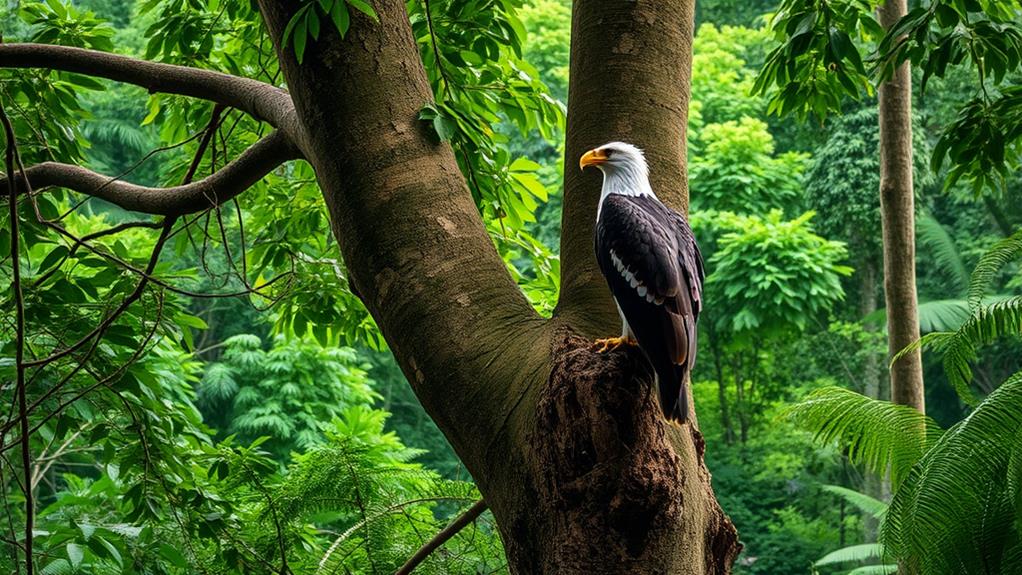
The Philippine Eagle's diet consists of a diverse range of prey, showcasing its adaptability in various habitats.
The eagle's diet includes monkeys and flying squirrels, bats and civets, birds, snakes, and lizards.
This varied diet is a result of its ability to adapt to different environments.
The Philippine Eagle employs remarkable hunting strategies to catch its prey.
With exceptional vision, the eagle spots potential prey from considerable heights, allowing it to swoop down with precision.
Its hunting techniques include patient waiting, flying through the canopy, and pair hunting, where one eagle distracts the prey while the other makes the capture.
The Philippine Eagle requires expansive, undisturbed habitats for successful hunting and survival.
A breeding pair of eagles needs an average of 10 to 20 square kilometers of undisturbed habitat.
Injuries during prey encounters can significantly threaten their survival.
Therefore, protecting the eagle's hunting grounds is essential not only for its diet but also for the overall health of the ecosystem.
Conservation Status
Conservation Status of the Philippine Eagle
The Philippine Eagle is Critically Endangered
The Philippine Eagle is classified as critically endangered by the International Union for Conservation of Nature (IUCN), with fewer than 400 breeding pairs remaining in the wild.
Habitat destruction, hunting, and pollution are the main threats to its survival. Habitat destruction from logging, mining, and agricultural expansion reduces available forest, making it difficult for the eagle to find food and shelter.
Hunting and illegal capture also pose a significant threat, while pollution affects their health and breeding success.
Conservation Efforts
The Philippine Eagle Foundation is working to reverse this trend by focusing on habitat protection and restoration.
They engage local communities to promote sustainable practices and raise awareness about the importance of preserving the eagle's habitat.
Legislative actions are underway to strengthen wildlife protection laws, providing a legal framework for conservation efforts.
Role of Community Engagement and Awareness
Community engagement is crucial in the conservation of the Philippine Eagle.
Local populations must understand the importance of preserving the eagle's habitat and the ecosystem as a whole.
By fostering sustainable practices and raising awareness, the foundation helps build a supportive network for conservation.
Your awareness and participation can amplify these initiatives, ensuring that future generations will witness the soaring flight of the Philippine Eagle.
Community Involvement
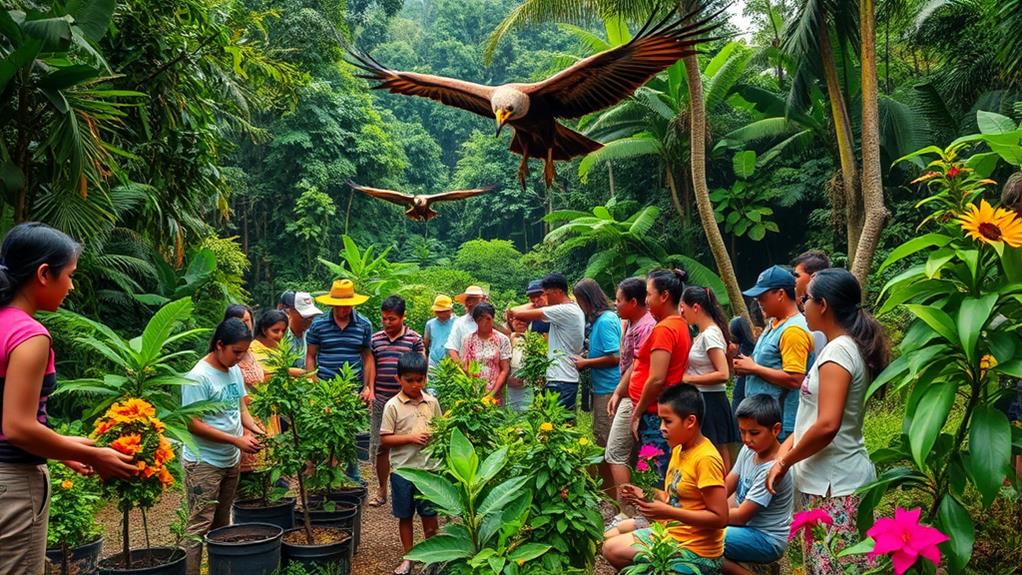
Community Involvement is Crucial for Philippine Eagle Conservation
Community involvement is essential for the conservation of Philippine Eagles, as local populations are the first line of defense against threats like hunting and habitat destruction. The Philippine Eagle Foundation (PEF) has launched projects since 2019 that integrate local knowledge with scientific methods, fostering a sense of ownership among residents.
Benefits of Community Involvement
Increased Awareness: Educational programs raise awareness about the ecological significance of Philippine Eagles, emphasizing their role in the ecosystem. For example, the PEF's educational programs have taught local communities about the importance of preserving the eagles' habitats.
Sustainable Practices: By encouraging locals to adopt sustainable practices, they contribute to both wildlife conservation and their own livelihoods. For instance, sustainable farming practices reduce habitat destruction and promote eco-friendly livelihoods.
Long-term Commitment: Involvement fosters a commitment to protecting habitats, ensuring a sustainable future for both eagles and local populations. This commitment leads to a long-term investment in conservation efforts.
Empowering Local Communities
Building strong relationships with local communities not only enhances conservation efforts but also empowers them to take action. This involvement sparks a ripple effect, creating a united front against the challenges that threaten these majestic raptors.
Conservation Efforts
Conservation Efforts Save the Philippine Eagle
The Philippine Eagle's survival depends on dedicated conservation efforts. The Philippine Eagle Foundation (PEF) has led these initiatives since 1992, focusing on habitat protection and public education. For instance, they have rehabilitated injured eagles, releasing notable individuals like Carlito and Uswag back into the wild.
Community Engagement is Key
Community-based conservation initiatives are crucial. These programs raise local awareness and engage communities in protecting essential nesting sites. By doing so, they empower locals to take action in preserving the eagle's habitat.
Legislative Actions Strengthen Wildlife Protection
Legislative actions are equally vital. Proposed amendments to Republic Act 9147 strengthen wildlife protection laws against poaching and habitat destruction. This ensures that the Philippine Eagle and its habitat receive the necessary protection.
Conservation Efforts Have a Lasting Impact
The following table highlights the impact of these efforts:
| Conservation Efforts | Impact |
|---|---|
| Habitat Protection | Preserves nesting sites |
| Community Engagement | Empowers locals |
| Legislative Strengthening | Safeguards against poaching |
Collaborations Enrich Conservation Strategies
Collaborations with organizations like The Peregrine Fund enrich the data pool on Philippine Eagle populations, improving monitoring and informing conservation strategies. This collective effort forms a robust framework aimed at saving this endangered raptor, ensuring that future generations can admire the majestic Philippine Eagle in its natural habitat.
Importance of Conservation
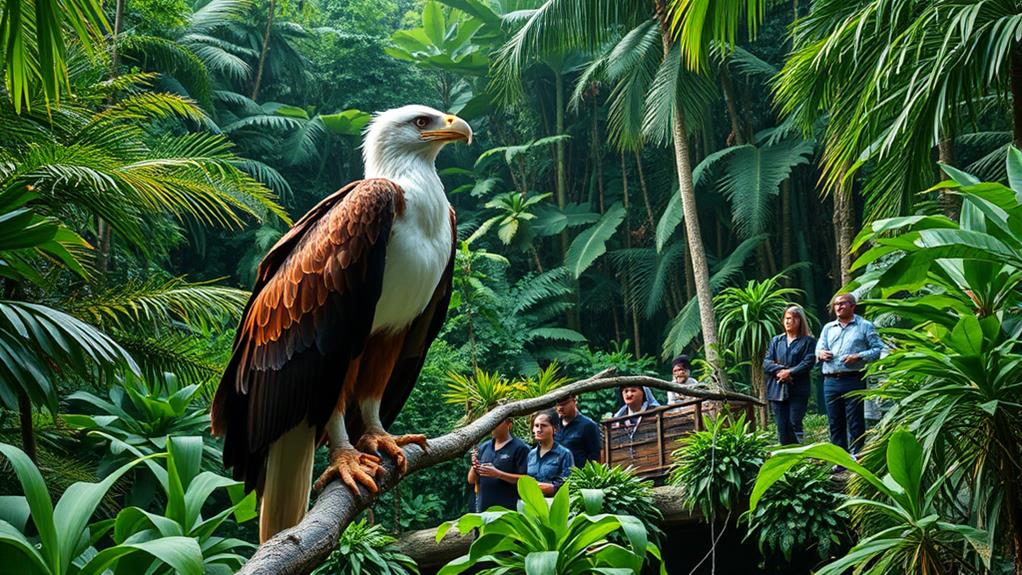
The significance of conservation efforts extends far beyond the survival of a single species like the Philippine Eagle.
Protecting this majestic bird is crucial for maintaining the delicate balance of biodiversity within its ecosystem. As an apex predator, the Philippine Eagle regulates various populations, ensuring healthy interactions among species.
Conservation efforts have cultural significance, as the eagle holds a deep cultural significance for indigenous communities, symbolizing their connection to nature. For example, the Philippine Eagle is considered a sacred animal by the indigenous Tagbanua people, representing strength and freedom.
Conservation initiatives can generate economic benefits by enhancing local livelihoods through projects that promote biodiversity-friendly practices. For instance, ecotourism initiatives can create jobs and stimulate local economies while promoting the conservation of the Philippine Eagle's habitat.
Safeguarding the Philippine Eagle supports ecosystem health by preserving pristine forests, which are essential for numerous wildlife species. The conservation of the eagle's habitat also helps maintain the quality of water sources and prevents soil erosion, benefiting both humans and wildlife.
Morphological Studies
Morphological Traits and Survival Strategies
The Philippine Eagle and other raptors' survival strategies are closely tied to their morphological traits, which are crucial for adapting to varying habitats. A recent study of 21 Philippine raptor species revealed significant correlations between morphological traits, habitat preferences, and behavioral adaptations.
Wing Shape and Tail Structure
Wing shape and tail structure are critical for species' adaptability, especially for endangered rainforest raptors, which face constraints limiting their habitat flexibility.
For instance, wing shape and tail structure are crucial for species' adaptability in rainforests.
Body Size Variation
Understanding the latitudinal gradient in body size variation, as seen in the Philippine Falconet, highlights diverse evolutionary pressures impacting these birds.
The body size variation across different islands informs recovery strategies.
Conservation Implications
By discerning the physical characteristics essential for survival, we can better inform habitat protection strategies and species recovery plans.
Tailoring habitat protection to wing shape, enhancing adaptability measures based on tail structure, and informing recovery strategies with body size variation are crucial conservation implications.
Incorporating these insights into conservation strategies is essential to prevent the extinction of these majestic raptors. In addition to incorporating these insights into conservation strategies, it is crucial to prioritize habitat protection and restoration for these raptors. Conservation efforts for tamaraws, such as establishing protected areas and implementing sustainable land use practices, will also benefit the overall ecosystem and help to ensure the survival of these birds of prey. By taking a holistic approach to wildlife conservation, we can work towards preventing the extinction of these majestic raptors and other endangered species.
Health Monitoring
Health Monitoring of Philippine Eagles: A Crucial Conservation Effort
Monitoring the health of Philippine Eagles is essential for their survival and conservation. This process helps identify and address diseases that could threaten their populations.
Disease Prevalence: A Significant Concern
A study revealed a 38.11% positivity rate for Newcastle Disease Virus (NDV) antibodies in 42 captive raptors, indicating significant health risks.
Effective Health Monitoring Strategies
To ensure the health and well-being of Philippine Eagles, the following strategies are critical:
- Continuous surveillance: Monitoring disease prevalence in both captive and wild populations helps identify health risks early on.
- Advanced techniques: Utilizing methods like PCR amplification enables accurate sex identification in eagles, which is vital for conservation efforts.
- Recovery programs: Implementing programs that focus on the health needs of Philippine Eagles supports their recovery and survival.
Research and Data Resources
Reliable research and data resources are essential for Philippine Eagle conservation. The Global Raptor Information Network provides comprehensive data on population status and trends. Ongoing research initiatives focus on breeding behavior, habitat preferences, and ecological needs, informing effective conservation strategies.
Collaboration between researchers and the Philippine Eagle Foundation is crucial. They partner to monitor eagle populations and track nesting sites, enabling community-based conservation programs that engage local communities in protecting these raptors.
Innovative DNA sexing techniques have improved captive breeding. PCR amplification allows for accurate sex determination, enhancing knowledge of life history and breeding patterns. This understanding is vital for future conservation efforts.
Health monitoring studies inform conservation strategies. Data on the prevalence of Newcastle Disease Virus, for example, is crucial for ensuring the well-being of both captive and wild populations.
Advocacy and Awareness
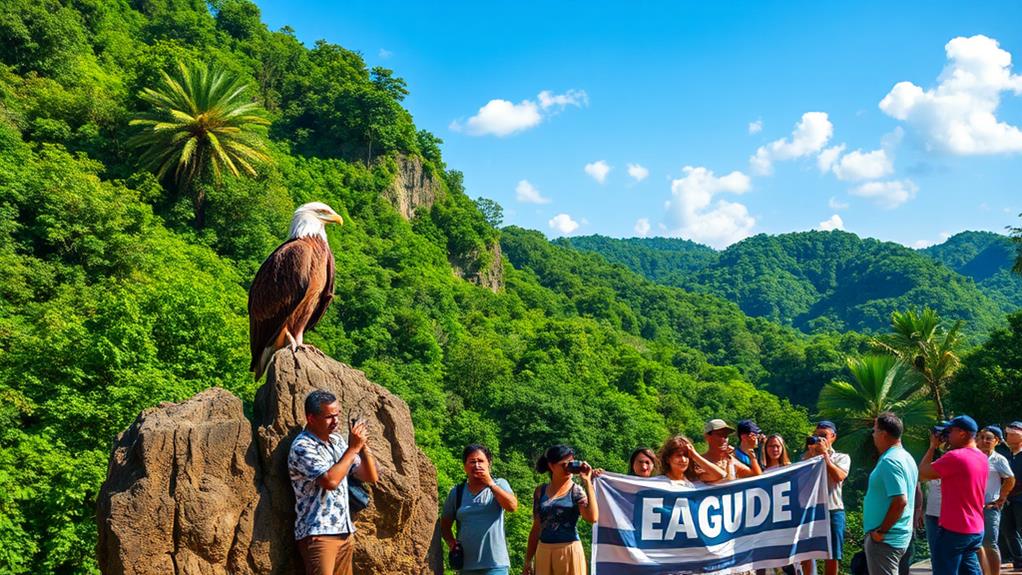
The Philippine Eagle's Survival Depends on Advocacy and Awareness
With fewer than 400 nesting pairs left in the wild, the Philippine Eagle is critically endangered due to habitat loss and hunting. Robust advocacy and heightened public awareness are crucial for its survival.
Educate Yourself and Others
To make a difference, participate in educational campaigns with organizations like the Philippine Eagle Foundation, which teaches about biodiversity conservation.
This knowledge can be shared with communities to emphasize the importance of preserving the Philippine Eagle and its habitat.
Utilize Social Media for Awareness
Spread awareness about the Philippine Eagle's plight by sharing posts, signing online petitions, and advocating for stronger wildlife protection laws on social media platforms.
This helps raise awareness and mobilize community action.
Support Legislative Changes
Encourage your local representatives to back proposed amendments to Republic Act 9147, which aims to increase penalties for wildlife violations.
This can lead to significant improvements in wildlife protection legislation.
Collective Advocacy Yields Results
By raising awareness and actively participating in advocacy, community action can be mobilized, and a sense of responsibility towards preserving the Philippine Eagle can be fostered.
This collective effort can ensure the national symbol thrives for generations to come.
How Can Sustainable Development Efforts in the Philippines Help Protect the Philippine Eagle?
Sustainable development efforts in the Philippines can play a vital role in protecting the endangered Philippine Eagle by preserving its natural habitat. Initiatives like sustainable development through nature in philippines promote reforestation, responsible land management, and community-driven conservation, ensuring the eagle’s forests thrive while supporting local livelihoods in harmony with nature.
Future of Philippine Eagles
The Philippine Eagle's Fate Depends on Urgent Conservation Efforts
The Philippine Eagle is critically endangered, with fewer than 400 pairs remaining.
Habitat preservation is crucial, as an alarming 40,000 hectares of forest are lost annually due to logging and agricultural expansion.
Local community engagement is key to conservation success, as protected nesting sites and habitats lead to successful outcomes.
Reproductive Success is Vital for Population Stability
The Philippine Eagle's low reproductive frequency of every 2-3 years highlights the need for enhanced reproductive success.
Stronger wildlife protection laws and increased penalties for poaching and habitat destruction are necessary to safeguard their future.
Public Education and Awareness are Essential for Change
Changing perceptions about the Philippine Eagle is crucial, as it's often wrongly viewed as a threat to livestock.
Ongoing public education and awareness campaigns can foster a culture of respect and protection for this endangered species.
Questions and Answers
How Can We Protect the Philippine Eagle From Extinction?
Preserve Habitats to Safeguard the Philippine Eagle
The Philippine eagle's survival relies heavily on preserving its natural habitats.
Habitat preservation efforts should focus on protecting the remaining forests, particularly in the Sierra Madre mountain range, where the eagle's population is concentrated. This can be achieved by supporting reforestation programs and advocating for policies that prevent deforestation.
Raise Awareness Through Education
Conservation education plays a vital role in raising awareness about the eagle's plight.
Education campaigns should target local communities, emphasizing the importance of preserving the eagle's habitat and the ecosystem it inhabits. This can be achieved through workshops, school programs, and community outreach initiatives.
Combat Poaching and Establish Wildlife Corridors
Anti-poaching laws and enforcement are crucial to preventing the illegal hunting of Philippine eagles. Supporting conservation organizations and law enforcement agencies in their efforts to combat poaching can help protect the eagle.
Additionally, establishing wildlife corridors can connect fragmented habitats, enabling the eagle to roam freely and find food.
Collaboration is Key to Conservation
Collaboration between local communities and conservation organizations is essential for creating a sustainable future for the Philippine eagle.
How Many Philippine Eagles Are Left in 2024?
In 2024, there are fewer than 400 breeding pairs of Philippine Eagles left.
The critically low population of Philippine Eagles is threatened by habitat destruction from logging and agriculture.
Habitat loss and fragmentation reduce the available space for the eagles to build their nests, hunt, and raise their young.
Conservation efforts are underway to stabilize the population.
These efforts include breeding programs, which involve artificial incubation and chick-rearing to increase the number of eagles, and habitat protection, which involves establishing sanctuaries and patrolling against loggers and poachers.
Local communities and ecotourism can play a vital role in supporting these initiatives.
By engaging local communities in eagle conservation, they become invested in protecting the eagles and their habitats. Ecotourism, which involves responsible wildlife viewing, can generate income and provide an incentive for communities to conserve eagle habitats.
By participating in these efforts, individuals can contribute to the survival of the Philippine Eagle and its ecosystem.
Every action, no matter how small, counts in the conservation of this majestic species.
Are Philippine Eagles Endangered or Extinct?
Philippine Eagles are critically endangered, not extinct.
The main threats to their survival are habitat destruction, illegal hunting, and fragmentation. For example, the destruction of their natural habitats due to deforestation and urbanization has led to a significant decrease in their population.
Conservation efforts, such as breeding programs, are underway to increase their numbers. However, these initiatives are often insufficient to counter the dangers they face.
To effectively protect the Philippine Eagles, strong public awareness and community involvement are necessary. This can be achieved by advocating for habitat preservation and stricter laws to prevent their extinction.
Why Is the Philippine Eagle Important to the Ecosystem?
The Philippine Eagle plays a vital role in maintaining ecosystem balance. It does this by controlling prey populations, which in turn promotes biodiversity. This is crucial for a balanced environment, as it ensures that no single species dominates the ecosystem.
For example, if the eagle didn't control the population of its prey, such as rodents and deer, they'd overpopulate and degrade their habitats.
The eagle also serves as an umbrella species, meaning that its conservation benefits other species that share its habitat. By protecting the eagle and its habitat, we also protect other species that depend on the same ecosystem.
This is especially important in the Philippines, where the eagle's habitat is threatened by deforestation and habitat fragmentation.
Conservation efforts are essential to protect the Philippine Eagle and its habitat. Without these efforts, the eagle's population will decline, leading to ecosystem destabilization and loss of biodiversity.